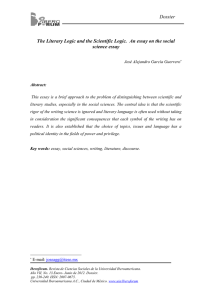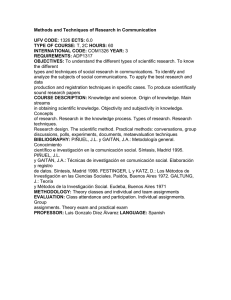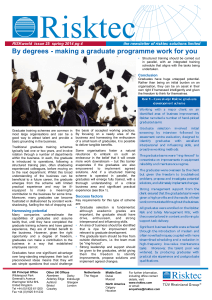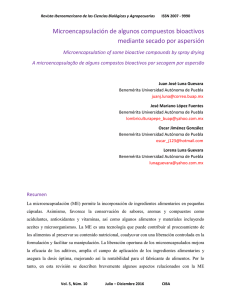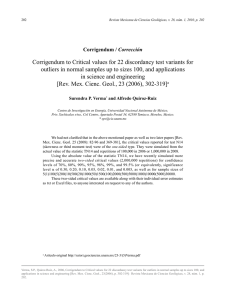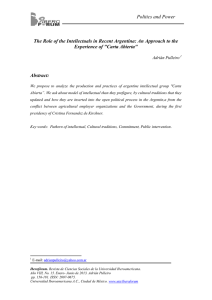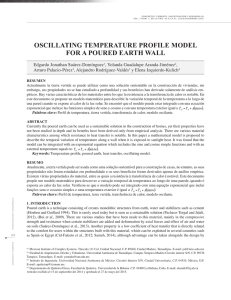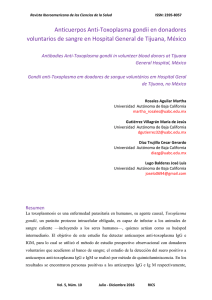Estudio de egresados, un indicador de pertinencia y calidad
Anuncio
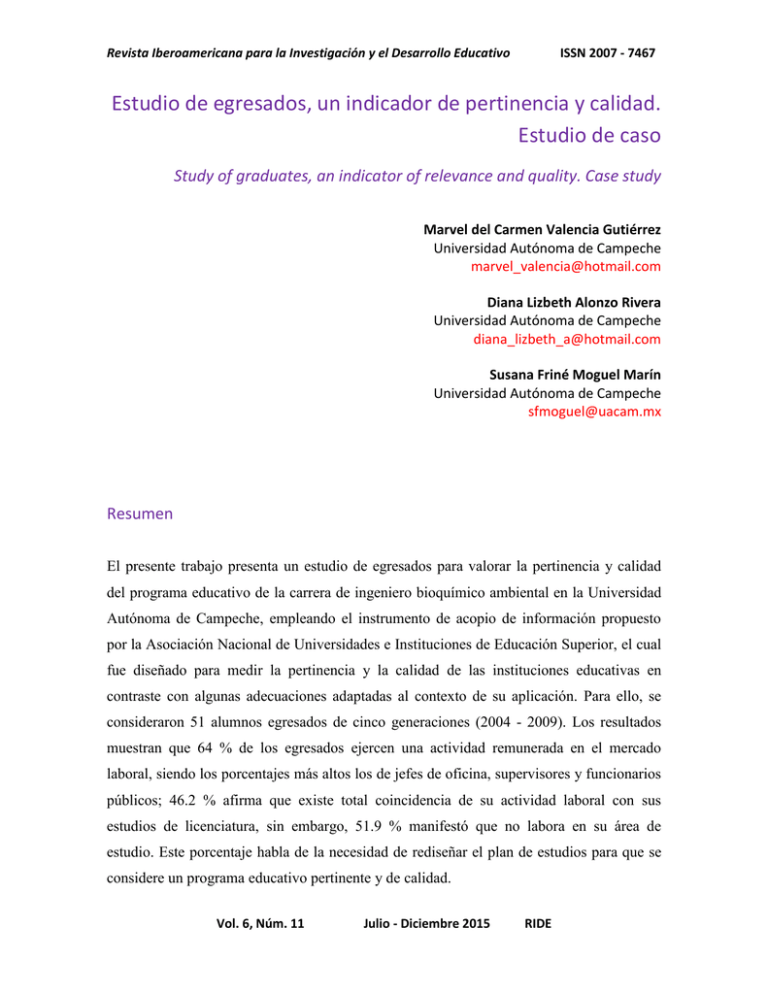
Revista Iberoamericana para la Investigación y el Desarrollo Educativo ISSN 2007 - 7467 Estudio de egresados, un indicador de pertinencia y calidad. Estudio de caso Study of graduates, an indicator of relevance and quality. Case study Marvel del Carmen Valencia Gutiérrez Universidad Autónoma de Campeche marvel_valencia@hotmail.com Diana Lizbeth Alonzo Rivera Universidad Autónoma de Campeche diana_lizbeth_a@hotmail.com Susana Friné Moguel Marín Universidad Autónoma de Campeche sfmoguel@uacam.mx Resumen El presente trabajo presenta un estudio de egresados para valorar la pertinencia y calidad del programa educativo de la carrera de ingeniero bioquímico ambiental en la Universidad Autónoma de Campeche, empleando el instrumento de acopio de información propuesto por la Asociación Nacional de Universidades e Instituciones de Educación Superior, el cual fue diseñado para medir la pertinencia y la calidad de las instituciones educativas en contraste con algunas adecuaciones adaptadas al contexto de su aplicación. Para ello, se consideraron 51 alumnos egresados de cinco generaciones (2004 - 2009). Los resultados muestran que 64 % de los egresados ejercen una actividad remunerada en el mercado laboral, siendo los porcentajes más altos los de jefes de oficina, supervisores y funcionarios públicos; 46.2 % afirma que existe total coincidencia de su actividad laboral con sus estudios de licenciatura, sin embargo, 51.9 % manifestó que no labora en su área de estudio. Este porcentaje habla de la necesidad de rediseñar el plan de estudios para que se considere un programa educativo pertinente y de calidad. Vol. 6, Núm. 11 Julio - Diciembre 2015 RIDE Revista Iberoamericana para la Investigación y el Desarrollo Educativo ISSN 2007 - 7467 Dicho seguimiento de egresados está considerado dentro del rubro “vinculación extensión” por el comité acreditador de este programa educativo, el CACEB. Palabras clave: pertinencia, programa educativo, ingeniero bioquímico. Abstract This paper presents a study of graduates to assess the relevance and quality of the educational program of environmental biochemical engineer career at the Autonomous University of Campeche, using the instrument of collection of information proposed by the National Association of Universities and Institutions of Higher Education, which was designed to measure the relevance and quality of the educational institutions in contrast with some adaptations suited to the context of your application. For this purpose, we considered 51 students graduated from five generations (2004-2009). The results show that 64% of the graduates have a remunerated activity in the labour market, being the highest percentages of office managers, supervisors and Government officials; 46.2% say that there is a total coincidence of their work with their studies of Bachelor's degree, however, 51.9% stated that not working in their field of study. This percentage speaks of the need to redesign the curriculum that is considered a relevant educational program and quality. Such monitoring of graduates is considered under the category "linkage-extension" by the accrediting Committee of this educational program, the CACEB. Key words: relevance, educational program, biochemical engineer. Fecha recepción: Diciembre 2014 Vol. 6, Núm. 11 Fecha aceptación: Abril 2015 Julio - Diciembre 2015 RIDE Revista Iberoamericana para la Investigación y el Desarrollo Educativo ISSN 2007 - 7467 Introduction Nowadays the trend in higher education is oriented towards the evaluation of the results of educational processes at different levels, as well as to the relevance, feasibility and linking of educational programs with the productive sectors and service, which are indicators of quality in educational institutions. The United Nations Educational, Scientific and Cultural Organization (UNESCO) (1998), points out that higher education must be oriented to the relevance, and must assess the role of education to compare what society expects of institutions and what they do. It also notes that in an economic context characterized, by changes and the emergence of new knowledge-based production models and their applications, as well as in the treatment of the information should be strengthened and renewed links between higher education, the world of work and other sectors of society. Studies of graduates constitute one of the most appropriate strategies for feedback educational programs; the performance of graduates in the labour market is one of the reliable indicators of relevance, adequacy and timeliness of educational programs which supported its formation (Fresán, 1998). The proposals of the National Association of Universities and Higher Education Institutions (ANUIES), are aimed at "the integral improvement and the assurance of the quality of the higher education system-understanding that the concept of quality, include those of relevance, coverage, efficiency, level of performance and equity". The National Association of universities and institutions of higher education, ANUIES (2000), in the book the higher education in the 21st century, set fourteen programs or proposals of actions for institutions of higher education, the higher education system and the State. Institutions of higher education have main function prepare highly qualified personnel for the various sectors of the academic, economic, social and political activity; generate knowledge, develop technology, as well as preserving and spreading the culture. With the support of the results obtained in a study of graduates, discusses the relevance and quality of the educational program of the environmental biochemical engineer, program Vol. 6, Núm. 11 Julio - Diciembre 2015 RIDE Revista Iberoamericana para la Investigación y el Desarrollo Educativo ISSN 2007 - 7467 that is taught in the Faculty of Sciences chemical biological of the Autonomous University of Campeche so that students, teachers and education authorities have a panorama of the current educational situation and implement strategies for quality higher education. DEVELOPING The educational program of environmental biochemical engineer race was created in 1996, adding 18 generations with 79 professionals in total. This research asked about their employment status to determine the relevance and quality of the educational program. Graduate studies have been used by the Institutions of Higher Education (IES) for information that supports the establishment of various strategies or institutional improvement actions. In this case, they were used to evaluate the congruence or incongruity between these professionals received training at the university and the activities carried out in the working world (Cu, Aragon and Alonzo, 2007). In this context, the National Association of Universities and Institutions of Higher Education proposes that colleges provide students with a comprehensive education responsible criticism, humanistic and enable graduates to be able to venture into the scientific, technological and professional media. Thus it is responding to the needs and challenges of Mexican society, giving opportunities for welfare. University education should have a profile of skills and / or skills to achieve high production level and contribute to the expanding world market, however, the human sense should not be overlooked, since it works with human beings and not with machines. The World Bank encourages specialization and carries an enormous expansive force of progress on the economy, but there is an intellectual and spiritual regression; the sacrifice of culture leads to the loss of values (ANUIES, 2000). METHODOLOGY There are many methodologies to conduct studies and follow-up of graduates; the National Association of Universities and Institutions of Higher Education (ANUIES, 1998) in its basic outline for graduate studies, proposes a methodology that facilitates the higher education institutions conducting such studies and ensure homogeneity in proceedings of Vol. 6, Núm. 11 Julio - Diciembre 2015 RIDE Revista Iberoamericana para la Investigación y el Desarrollo Educativo ISSN 2007 - 7467 obtaining information. The data collection instrument proposed by the ANUIES, is designed to measure the relevance and quality of educational institutions. This work is not used integrally collection instrument proposed by the ANUIES information but adapted it according to the circumstances of context. To obtain information ANUIES's proposal, which recommends orienting the graduates to study cohorts who have been about five years in the labor market is considered. In the event of the intention of a larger study is recommended that graduates of contiguous generations or cohorts that have been formed with the same curriculum. To follow-up studies conducting follow-up studies on a sample of the cohort considered in a study of performance of graduates, three or four years after the study (ANUIES, 1998) is considered desirable. The results were processed with statistical program called Statistical Package Seach Serial (SPSS). Type and design research. The quantitative research is cut, not experimental, transversal, because the information was collected in a single moment; also is exploratory-descriptive because the variables set allow us to an initial explanation, which could be the prelude to other research on the subject and to analyze how the factors involved in the labor market (Hernandez, 2007) manifest . Population and sample population The choice of the population of graduates was analyzed an informal selection of type called probabilistic available groups. Sample For this study population were grouped as shown in Table 1. Vol. 6, Núm. 11 Julio - Diciembre 2015 RIDE Revista Iberoamericana para la Investigación y el Desarrollo Educativo ISSN 2007 - 7467 Table No. 1 Generations Environmental Education Program biochemical engineer. Generación Egresados estudiados 2004 5 2005 10 2006 10 2007 8 2008 9 2009 9 TOTAL 51 The variable studied is described in Table 2. Table No. 2 Definition of the variable Vol. 6, Núm. 11 Julio - Diciembre 2015 RIDE Revista Iberoamericana para la Investigación y el Desarrollo Educativo DEFINICIÓN ISSN 2007 - 7467 DEFINICIÓN VARIABLE CLASIFICACIÓN CONCEPTUAL OPERACIONAL Grado de 1. Nula que 2. Baja coincidencia existe con 4. Total estudios “Se considera… en función de su cometido y su puesto sociedad, en de sus funciones con respecto la enseñanza, investigación servicios… profesionales realizados. la Pertinencia a los 3. Mediana Ubicación laboral o 1. Alto nivel jerárquico la y los con el 2. Medio alto 3. Medio 4. Medio bajo 5. Bajo mundo de trabajo”. (UNESCO, 1998) Valoración personal 1. Mejoró del egresado con su 2. Está igual situación laboral. 3. Empeoró 4. No aplica Vol. 6, Núm. 11 Julio - Diciembre 2015 RIDE Revista Iberoamericana para la Investigación y el Desarrollo Educativo ISSN 2007 - 7467 RESULTS The results obtained through the proposed by ANUIES in the core, which was modified to the context of their application by teachers from the Autonomous University of Campeche, and applied to graduates of the Educational Program Environmental Biochemical Engineering scheme questionnaire are presented belonging to generations of graduates 2004-2009. Marital status and age: Some general aspects of the study population are presented. With regard to marital status, the following was obtained: 31 % Soltero 69 % casado Figure 1. Marital status of graduates. In the graph 1 it shows that the highest percentage (69%) of graduates report being subjected to study single and 31% married. With respect to age the following results were found: Vol. 6, Núm. 11 Julio - Diciembre 2015 RIDE Revista Iberoamericana para la Investigación y el Desarrollo Educativo 7% ISSN 2007 - 7467 38 % de 20-25 de 26-29 55 % de 30-35 Figure 2. Age of graduates. The graph shows that 55% of graduates has an age range of between 26-29 years, this being the predominant age range. Regarding employment status, current employment of graduates is shown in Figure 3. Trabaja 36 % 64 % si no Figure 3. Employment status of graduates. Vol. 6, Núm. 11 Julio - Diciembre 2015 RIDE Revista Iberoamericana para la Investigación y el Desarrollo Educativo ISSN 2007 - 7467 As shown in Figure 3, 64% of graduates surveyed were working at the time of the study. It is noteworthy that these are all employees and none owns a company. Regarding the legal status of the company / institution where they work, 50% is public and 50% private, no social. 64% of graduates who work, 28% in addition to his main job reported having another job in order to earn higher income and meet their personal and / or family expenses. When asked about the size of the company where they work the following was obtained: Tamaño de la empresa/institución Muy grande 34.6 Grande 11.5 Pequena Tamaño de la empresa/institución 19.2 Micro 34.6 0 10 20 30 40 Figure 4. Size of the company and institution. Figure 4 shows the size of the companies where they work, represented by its number of employees. It was found that 34.6% are working in companies with up to 15 employees, ie companies "micro" and the remaining 34.6% work in companies with more than 251 employees, or "very large" companies. With regard to income earned, we have the following: Vol. 6, Núm. 11 Julio - Diciembre 2015 RIDE Revista Iberoamericana para la Investigación y el Desarrollo Educativo ISSN 2007 - 7467 Ingresos 25.9; 25 % 33.3; 33 % 1000-3000 3001-6000 42.7; 42 % 6001-1200 Figure 5. Income of graduates. Figure 5 shows the income range. According to data provided by the graduates, 42.7% obtained income amounting to $ 3,000 and $ 6,000 Mexican pesos, equivalent to US $ 456 and 912, or 507 and 1001 euros, approximately. In the graph 6 it shows that 51.9% of graduates not working in their field of study, as opposed to those that are working, totaling 48.1%. Trabaja en su área de estudio 48.1; 48 % 51.9; 52 % Si No Figure 6. Work related to the study area. Vol. 6, Núm. 11 Julio - Diciembre 2015 RIDE Revista Iberoamericana para la Investigación y el Desarrollo Educativo ISSN 2007 - 7467 Figure 6 shows if working in their field of study, 48.1% said yes and 51.9% reported no. This is a relevant fact as this is inferred if the curriculum is relevant or not. In the opinion of the graduates, their work coincides with the educational program completed studies at university as follows: Coincidencia de actividad laboral y estudios de licenciatura 30.80 % NULA 46.20 % BAJA MEDIANA 11.50 % TOTAL 11.50 % Figure 7. Matching the labor activity and studies of the degree. As shown in Figure 7, the highest percentage, 46.2% said that there is total agreement, but 30.8% indicates that the match is null and 11.5% which is low. With regard to the position they occupy, in Table 3 we can see that the highest percentages placed as head of the office, supervisor or official. Vol. 6, Núm. 11 Julio - Diciembre 2015 RIDE Revista Iberoamericana para la Investigación y el Desarrollo Educativo ISSN 2007 - 7467 Table 3. Positions occupied by graduates. Puestos ocupados % Gerente/director de área 3.7 Jefe de departamento 3.7 Jefe de oficina/sección/área 14.8 Empleado profesional 3.7 Supervisor/auxiliar 11.1 Analista especializado/técnico 7.4 Vendedor en establecimiento 3.7 Asistente/ayudante 3.7 Funcionario público/político 11.1 Otro 37 Functions other than those provided by the questionnaire were: • Sales Advisor • Impact Project Coordinator • Baker •Police •Laboratory technician • Supervisor • Charge Vol. 6, Núm. 11 Julio - Diciembre 2015 RIDE Revista Iberoamericana para la Investigación y el Desarrollo Educativo ISSN 2007 - 7467 CONCLUSIONS Graduate studies are a key instrument for self-assessment, evaluation and accreditation of educational programs as possible to assess the degree of social compliance and relevance of graduate profiles. The opinion of the graduates on the usefulness of the training college for entry, stay and / or promotion in the workplace, is extremely valuable for improving and updating plans and curricula, enabling the continuous quality assurance. The job performance of graduates is undoubtedly reliable to estimate the relevance, adequacy and quality of educational programs indicator because it allows continuing suitability according to supply and demand in the labor market; also it provides valuable for the design of strategies that enable continuous quality improvement in education information. According to the results obtained from this study it shows that 64% of graduates of the degree of environmental biochemical engineer active in the workplace at the time of the investigation; the highest percentages placed as head of the office, supervisor and public servant, only 48.1% work in their field of study, while 51.9% reported that their work has nothing to do with their university studies. This high percentage necessary to consider the need to update the curriculum of the degree to achieve the full relevance of the educational program. However, 46.2% of graduates said that there is complete overlap between their work and their professional studies. Although the public and private sectors demand graduates biochemical engineering environmental area, such productive sectors offer low-income situation makes seek other opportunities other than their area of employment but studies have sufficient financial compensation to cover their basic needs . On the other hand, there is no link with the productive sectors and social services, since 36% of respondents still unemployed and underemployed, increasing their dissatisfaction. These results indicate the need to review the curriculum of environmental biochemical engineer and update it taking into account the current demands of the productive sector. Furthermore, these results are important to the process of updating the curriculum to be held in this 2015 at the Autonomous University of Campeche, and aims to ensure that Vol. 6, Núm. 11 Julio - Diciembre 2015 RIDE Revista Iberoamericana para la Investigación y el Desarrollo Educativo ISSN 2007 - 7467 graduates acquire the skills required by potential employers. That way you can improve the quality of the educational program and meet one of the indicators for the category "linkageextension", which sets the accrediting body of the educational program for recognition as a relevant program and quality. Bibliography ANUIES (1998). Esquema Básico para el Estudio de Egresados. Colección Biblioteca de la Educación Superior, Serie Investigaciones, México, Dirección de Servicios Editoriales de la ANUIES. ANUIES (2000). La Educación Superior en el Siglo XXI. Líneas Estratégicas de Desarrollo. Una Propuesta de la ANUIES, México, Dirección de Servicios Editoriales de la ANUIES. Ávila, H. y Aguirre C. (2005). El seguimiento de los egresados como indicador de la calidad docente. Revista Electrónica Interuniversitaria de la Formación del Profesorado (REIFOP).8 (3).ISSN: 1575-0965 disponible en http:// www.aufop.com/aufop/home/consultado:18/06/2015. Cu Balán, Guadalupe; Aragón Naal, Faustina; Alonzo Rivera, Diana (2007). Pertinencia y factibilidad de la educación superior en el estado de Campeche, Universidad Autónoma de Campeche. Fresán Orozco, Magdalena (1998). Esquema básico para estudios de egresados. Colección Biblioteca de la Educación Superior, Serie Investigaciones, México, Dirección de Servicios Editoriales de la ANUIES. Hernández, R., et al. (2007). Metodología de la Investigación, México, McGraw-Hill. UNESCO (1998). Conferencia mundial sobre la educación superior. La educación en el siglo XXI, México. Vol. 6, Núm. 11 Julio - Diciembre 2015 RIDE

